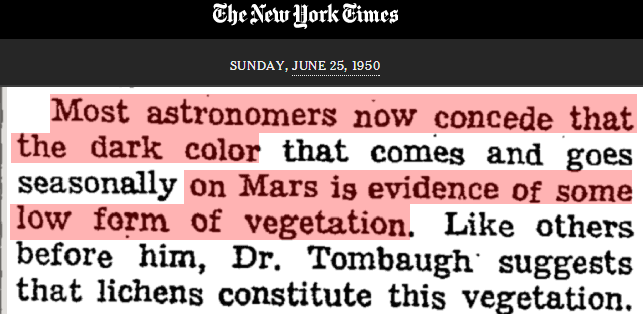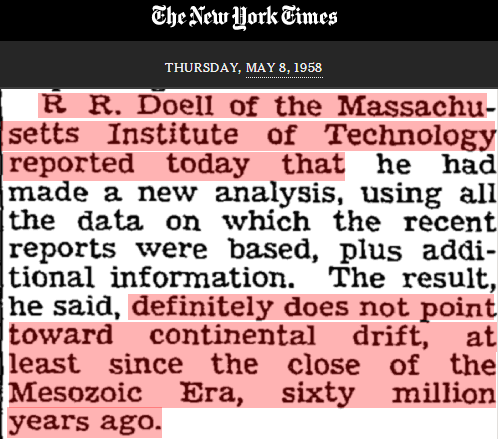In 1950, the scientific consensus was that continents don’t move, and that there was life on Mars
Disrupting the Borg is expensive and time consuming!
Google Search
-
Recent Posts
- The World’s Worst Scientists
- “Trees are feasting on decades of carbon dioxide emissions”
- A Real Hockey Stick
- A Real Hockey Stick
- Doubling Energy Costs
- Doubling Energy Costs
- “You Can’t Hide Your Lying Eyes”
- Australia Permanent Drought Update
- Let Them Burn Wood
- “New computer modeling”
- Climate Destroying Shrimp
- What’s At Stake?
- Too Hot To Live
- What’s At Stake?
- “The world began to end on 12th May 2024”
- “Climate change is a myth”
- Racist Gas
- RFK Jr. Discusses The Green New Deal And Climate
- “world is on edge of climate abyss, UN warns”
- Ivy Echo Chamber
- Climate Homicide
- Much Ado About Nothing
- Homophobic Gas
- World Bank Expectations
- Trained Not To Learn
Recent Comments
- Bruce of Newcastle on “Trees are feasting on decades of carbon dioxide emissions”
- Conrad Ziefle on The World’s Worst Scientists
- arn on “Trees are feasting on decades of carbon dioxide emissions”
- Francis Barnett on “Trees are feasting on decades of carbon dioxide emissions”
- arn on “Trees are feasting on decades of carbon dioxide emissions”
- Steve Cooksey on “Trees are feasting on decades of carbon dioxide emissions”
- spren on “You Can’t Hide Your Lying Eyes”
- Jack the Insider on Doubling Energy Costs
- Conrad Ziefle on Doubling Energy Costs
- Disillusioned on Doubling Energy Costs




It’s really hard to feel happening, except when … . Continents lurch more than they “drift”.
The quackitists also predicted life on Venus – anything to disparage human life on earth. Velikovsky and others predicted that Venus would have a surface temp of 1000 F. Sagan and other ‘experts’ called the deniers a wide variety of names. They said Venus would have the same atm. and climate as earth…well Venus is the cosmic hell with 1000 F surface temps. So much for consensus.
The continents were moved by design, at least into their present shapes and distribution. The design is so exact (the probability is one in a million million that they were placed by chance), and the supposed continental movements today so small, that it would take several hundred thousand years for them to move away from the designed placement (and that placement is but one small aspect of the design, which encompasses both the terrestrial and celestial spheres, and the entire solar system). And it has been only about 10 to 20 thousand years since the design was made, upon which all of the ever-popular “ancient mysteries” of man were afterwards based.
But today, almost everyone is bent on expressing their disdain for ideas that don’t fit the dogmas they have come to embrace (religiously)–confrontation, or knee-jerk condescension and dismissal, rather than professional consideration–and those who explicitly want to consider other ideas (like “tallbloke’s talkshop” or, in the wider arena, self-righteous, dangerous fools like Barack Obama) are indiscriminate in their considerations, and no more open than anyone else to the definitive truth, when it is presented to them (and no, I’m not perfect either, I’m just the discoverer of definitive new knowledge, of that great design of the “gods” who once were known and, unsurprisingly, worshipped, worldwide). There is a crisis of general scientific incompetence because of this long-nurtured embrace of dogma (of current, public, politically correct consensus) over dispassionate, strict reason, with a general inability to identify and focus upon definitive evidence that does not fit entirely, or even well, with anyone’s prejudices (among those who broadcast their views, especially–they being particularly certain they know the truth).
There is no solid foundation to any of the earth and life sciences today. The central theories in both–plate tectonics and undirected evolution–are simply, inescapably disproved by the design I have found and verified, many times over. They are poorly engineered–out of ever-hopeful but incompetent speculation–and do not work, as you engineers would say.
Please put evidence on Internet about your “I have found and verified” …”plate tectonics” … is disproved. Thank you.
His detailed discussion is here,
http://theendofthemystery.blogspot.com.br/2009/04/challenge-to-earth-scientists.html
In fact, it makes some sense if you think in terms of a long time effect associated with the motion of Earth’s axis of rotation with respect to the ecliptic, between 22.1 and 24.5 degrees (nutation). The angle Harry suggests in his article, of 63.435 degrees, plus the angle of nutation would be close to 90 deg, possibly suggesting that it’s connected with this oscillatory Earth’s movement in some way.
Lame attempts to explain Earth’s physical features using divine design plus a geometric ruler and compass only proves that the researcher (h. h.) has serious issues with his own religious faith and that he is afraid to face those issues less his own fragile faith is fatally compromised by the process.
Nobody with half a mind reads the NY Times. Its all bogus lies and propaganda.
“…at least since the close of the Mesozoic Era, sixty million years ago.”
So refusing to admit that something that was was known to be a working process long in the past, driving how the planet not only looks, but ‘works’ is nothing new. The ‘team’ is using the same tired argument to put CO2 as the control knob and dismiss any possible alternatives.
A peer-reviewed paper showing CO2 “forcing” continental drift would be the best laugh ever!!
I hope they’ll do it someday, maybe in connection with that damned heat at the bottom of the oceans!!
Don’t…just don’t.
I, in about 10 seconds after reading this, came up with 2 ways they could do this. Scary thong is, at least one of them is potentially ‘plausible’ (at least in today’s insane world of climate ‘science’).
Scary thong…yeah, that would be.
It should be ‘Scary thing..”
Maybe we “skeptics” should do some CO2 research too, not necessarily to deny anything, but just for the “fun and funds” of it.
We’re all humans after all, and after the scam collapses in a few years from now, we just write an “errata”, or “reanalysis” of our previous “research” and everything will be OK. 🙂
Tony, that dr. Tombaugh who suggested that lichens constitute the Mars vegetation, was that Clyde Tombaugh, the man who discovered the “planet” Pluto (that turned out later to be just a dwarf planet)? He was just a lucky man, who discovered Pluto in 1930 by comparison of photo’s in which Pluto moved in relation to the stars. His mathematical calculations in order to find “the nineth planet” were wrong. The size and the mass of Pluto were deliberately overexaggerated, Pluto is just a minor dwarf planet. Because it has this relatively large moon Charon and because it is an ice planet with a high albedo, it looked big, but it was not. This was known for a long time, but they kept the hoax of a new, nineth planet alive rather than admitting that is was just an insignificant dwarf planet.
Tombaugh spent years doing very precise calculations and making very precise measurements of Pluto, before he actually saw it through the telescope. I used to live a few blocks away from the observatory.
Hey, De Paus! “This was known for a long time, but they kept the hoax of a new, nineth planet alive rather than admitting that is was just an insignificant dwarf planet.”
I would respectfully disagree. The current classifications of planets, minor planets, dwarf planets, etc., are just matters of semantics. Useful semantics? Yes. Fundamental characteristics? No so much. There is no “hoax” involved, but rather a simple changing or perhaps sharpening of definitions. As astronomers have discovered a larger number and a wider range of objects, the need to (and ability to) more explicitly classify them has required a more exacting taxonomy.
Imagine an Earth that has only four types of mammals: humans, elephants, bears and dogs (my apologies to cat lovers.) On such an Earth, the classification of “mammal” would be perfectly adequate as a general class that had four specific elements. Now consider our Earth as it is with the multiple thousands of types of mammals, some of them very different in many aspects. While we can still use the word “mammal”, we have also the need to break that class into many subsets.
Anyway — go easy on the olde time astronomers. 🙂 They were doing the best they could with the information and paradigms they had. Time marches on, information accumulates, and language marches on as well.
Chiefio has a nice essay concerning this subject. http://chiefio.wordpress.com/2011/01/25/our-planets/
and here we have some speculations about life on Pluto,
“… Could it be life on Pluto? Not life as we know it of course, but some sort of cryo-life, spreading across the surface in vibrant but very cold color patterns.
I’m reminded of the early pre-mariner earth-based photos of Mars when we postulated that this was due to vegetation and seasons.
Can’t wait for New Horizons to arrive [at Pluto in 2015]. Too bad it doesn’t carry a small coffee-can sized orbiter that it could fling off and decelerate at the last minute to get planet-wide high resolution photos…”
just after NASA published the images taken by the Hubble Space Telescope in 2010
http://www.nasa.gov/mission_pages/hubble/science/pluto-20100204.html
the link for the quoted comment,
http://www.centauri-dreams.org/?p=11271#comment-78801